E

3 Fast track
Electricity Sector Workforce Projections for the 2022 ISP: Focus on Victoria.




Revision 1.
Final report
RACE for Everyone
Research Theme E3: Future Energy Workforce

ISBN: 978-1-922746-31-3
Industry Report
Electricity Sector Workforce Projections for the 2022 ISP: Focus on Victoria
This report has been revised to correct an error in modelling offshore wind employment and the omission of some pumped hydro employment from the Slow Change scenario.
Citation
Rutovitz, J., Langdon., R, Mey, F., Briggs, C. (2023) Electricity Sector Workforce Projections for the 2022 ISP: Focus on Victoria Revision 1 Prepared by the Institute for Sustainable Futures for RACE for 2030
January 2023
Contributors
Acknowledgements
We would like to thank the NSW and Victorian State governments for making this work possible. We would also like to thank our project partner the Australian Energy Market Operator (AEMO) for their invaluable help, and the Industry Reference Group: the Australian Power Institute, Clean Energy Council, Department of Climate Change Energy & Water (Commonwealth of Australia), Department of Energy and Public Works (Queensland), Department for Energy and Mining (South Australia), Energy Consumers Association, Energy Networks Association, Office of Energy and Climate Change (NSW Treasury), the University of NSW, and the Department of Environment Water Land and Planning (Victoria) for their insights, which have made this work much better. Any errors and omissions are, however, entirely the responsibility of the authors.
What is RACE for 2030?
RACE for 2030 CRC is a 10-year co-operative research program with AUD350 million of resources to fund research towards a reliable, affordable, and clean energy future: https://www.racefor2030.com.au
Acknowledgement of Country

The authors of this report would like to respectfully acknowledge the Traditional Owners of the ancestral lands throughout Australia and their connection to land, sea and community. We recognise their continuing connection to the land, waters and culture and pay our respects to them, their cultures and to their Elders past, present, and emerging.

Disclaimer
The authors have used all due care and skill to ensure the material is accurate as at the date of this report. The authors do not accept any responsibility for any loss that may arise by anyone relying upon its contents.
Electricity Sector Workforce Projections for the 2022 ISP: Focus on Victoria

2
Electricity Sector Workforce Projections for the 2022 ISP: Focus on Victoria 3 Contents 1 Introduction 5 2 Workforce projections for Victoria by scenario 7 3 Victoria - employment by occupation 10 4 Workforce projections by technology for Victoria 13 4.1 Wind 14 4.2 Rooftop solar and distributed batteries 16 4.3 Utility-scale PV 16 4.4 Large scale storage: utility batteries and pumped hydro 17 4.5 Transmission construction 19 5 Electricity sector workforce projections, by REZ 20 Appendix A Additional information on occupational breakdowns 24
Figures Figure 1 Average electricity jobs by State, 2023-2050 (Step Change) ........................................................................ 6 Figure 2 Victoria, electricity sector jobs by scenario 7 Figure 3 Victoria, jobs by phase (all scenarios) 8 Figure 4 Victoria, jobs by technology group (all scenarios) ....................................................................................... 9 Figure 5 Victoria, average occupational structure 10 Figure 6 Victoria, in-demand occupations during Step Change peak year (2033) 11 Figure 7 Victoria, in-demand occupations annual requirement by technology, Step Change .................................... 12 Figure 8 Victoria, average electricity sector jobs by technology and scenario 14 Figure 9 Victoria, jobs by technology (all scenarios) 14 Figure 10 Victoria, jobs in wind (all scenarios) ...................................................................................................... 15 Figure 11 Victoria, jobs in rooftop solar and distributed batteries (all scenarios) 16 Figure 12 Victoria, jobs in utility-scale solar (all scenarios) 17 Figure 13 Victoria, jobs in pumped hydro (Step Change, Hydrogen Superpower, Slow Change)................................ 18 Figure 14 Victoria, jobs in utility batteries (Step Change, Hydrogen Superpower, Slow Change) 18 Figure 15 Victoria, jobs in transmission construction (Step Change, Hydrogen Superpower, Slow Change) 19 Figure 16 Candidate REZs for Victoria, and the REZs with modelled employment .................................................... 20 Figure 17 Employment by Victorian REZ (all scenarios) 21 Figure 18 Employment in utility batteries by REZ and rest of Victoria, Step Change 21 Figure 19 Employment in utility-scale PV by Victorian REZ, Step Change and Offshore Wind .................................... 22 Figure 20 Employment in wind technology by Victorian REZ, Step Change and Offshore Wind 23 Figure 21 Victoria, in-demand occupations during peak year (2033) for the Hydrogen Superpower 24 Figure 22 Victoria, in-demand occupations annual requirement by technology, Hydrogen Superpower 24 Figure 23 Victoria, utility-scale PV average employment by occupation, 2023-2040 25 Figure 24 Victoria, utility-scale PV average employment by occupation, 2023-2040 25
List of
List of abbreviations
Acronym Term
AEMO Australian Energy Market Operator
GW/GWh Gigawatt / Gigawatt Hours
ISF Institute for Sustainable Futures
kW/kWh Kilowatt / Kilowatt Hours
NEM National Electricity Market
MW/MWh Megawatt /Megawatt Hours
O&M Operations & Maintenance
PV Solar Photovoltaic
Electricity Sector Workforce Projections for the 2022 ISP: Focus on Victoria 4
1 Introduction
This report provides electricity sector workforce projections for Victoria and is part of a wider project which provide projections for the National Electricity Market (NEM) based on the 2022 Integrated System Plan (ISP) developed by the Australian Energy Market Operator (AEMO). Projections cover electricity generation and transmission construction.

The project was undertaken by the Institute for Sustainable Futures, University of Technology Sydney (ISF) in collaboration with the AEMO and was funded by the RACE for 2030 Co-operative Research Centre and by the NSW and Victorian State governments. The project has benefited from an Industry Reference Group made up of state government, industry, and university representatives.
The report provides electricity sector workforce projections for Victoria broken down by technology, occupation, and location for three ISP scenarios and one sensitivity:
• The Step Change scenario: includes rapid consumer-led transformation of the energy sector and coordinated economy-wide action moving fast to fulfil Australia’s net zero policy commitments. Energy stakeholders consider this the most likely’ scenario, as the NSW Electricity Infrastructure Roadmap is broadly aligned with this scenario, and during this project Victoria and Queensland released energy plans similarly aligned.
• The Hydrogen Superpower scenario: includes strong global action, significant technological breakthroughs, and a near quadrupling of NEM energy consumption to support a hydrogen export industry. There is large-scale development of the renewable energy sector, especially in the 2030s and 2040s.
• The Slow Change scenario: features a slow pace of policy and technology change, assuming a challenging environment following the COVID-19 pandemic, with the risk of industrial load closures. This scenario is considered unlikely and would not reach Australia’s decarbonisation targets
• The Offshore Wind sensitivity: the ISP includes a sensitivity to the Step Change scenario that takes account of the Victorian target to build 9GW of offshore wind by 2040 and assumes a lower cost. In all other scenarios, no offshore capacity is projected until the late 2040s. Offshore wind displaces onshore wind and utility-scale solar and reduces the overall capacity needed, with 10% (13 GW) less generation capacity over the entire NEM by 2050 In Victoria, Offshore Wind reduces the overall generation capacity by 5% (1.4 GW) by 2050.
Electricity Sector Workforce Projections for the 2022 ISP: Focus on Victoria 5
The Progressive Change scenario was not included as the workforce profile is very similar to the Step Change.
To put the workforce demand in Victoria in context, Victoria accounts for an average of one fifth of the forecast electricity sector workforce (Figure 1). NSW is the leading state for renewable energy employment, averaging 20,600 full-time jobs per year, followed by Queensland (18,000) and Victoria (11,800). The share by technology is very similar for the three largest states, with solar contributing 37%, wind 27%-30% and batteries 17%-22%. South Australia has a higher proportion of wind (37%), while Tasmania has a very different distribution, with 29% of jobs in hydro.

See the main report The Australian Electricity Workforce for the 2022 Integrated System Plan: Projections to 2050 (Rutovitz et al, 2022). for details on the methodology including a full list of employment factors, results for the National Electricity Market as a whole, and a comparison of results by State, and recommendations for further work to support planning for workforce development.
Racefor2030.com.au/fast-track-reports
Electricity Sector Workforce Projections for the 2022 ISP: Focus on Victoria 6
Figure 1 Average electricity jobs by State, 2023-2050 (Step Change)
2 Workforce projections for Victoria by scenario

Employment projections for each of the four workforce scenarios are presented in Figure 2:
• Under the Step Change scenario, employment averages 12,000, increasing from 10,000 in 2023 to peak around 18,000.
• Under the Hydrogen Superpower scenario, employment averages 16,000 per year with strong growth in the 2030s and especially in the 2040s, to a peak around 28,000
• Under the Slow Change scenario, employment falls to a low of 5,000, and averages only 7,000 per year as the pace of energy transition slows
• The Offshore Wind scenario has somewhat lower employment compared to the Step Change scenario, with an average of 11,000 and a maximum of 12,000. This reflects the displacement of 9.6 GW of onshore wind and utility solar and 0.8 GW of peaking gas by 9 GW less labour-intensive offshore wind 1
Jobs are presented as full time equivalent (FTE) for each year and are the sum of people working on construction projects, operations and maintenance, manufacturing, and fuel supply for coal and gas generation in that year. One FTE could be one person working full time, two people working full time for six months, or an ongoing job in operations and maintenance. Construction jobs are by nature temporary, although workers may move from one project to another and be in continuous employment.
Figure 3 show the total employment by whether it is construction, manufacturing, operations and maintenance, or fuel supply. Under all scenarios, construction dominates the employment profile through the 2020s but ongoing operations and maintenance (O&M) employment gradually increases as the fleet of renewable energy generation and storage increases. In all scenarios, O&M employment is greater than 55% by 2050, varying from 56% in the Step Change to 63% in the Hydrogen Superpower scenario.
Manufacturing employment is relatively small, contributing only 2-3% of employment in all scenarios, reflecting the small proportion which occurs onshore. Australian governments and other stakeholders are considering policies to change this; increasing the onshore proportion to 30% for all technologies is projected to add up to 3,000 manufacturing jobs in Victoria.
Figure 4 shows the breakdown between renewable generation, fossil fuel generation, storage, and transmission construction. Most employment growth in all scenarios is produced by renewable energy. The proportion of coal and gas falls to 8% in the Step Change scenario and to 2% in the other three scenarios 2
1 Offshore wind is estimated to create 1.4 job-years/MW construction employment compared to 2.7 job-years per MW for onshore wind and 2.1 job-years/ MW for utility solar.
2 There is construction of a peaking gas plant projected for the early 2050s, which means there is a sudden increase in gas construction workers in the late 2040s.
Electricity Sector Workforce Projections for the 2022 ISP: Focus on Victoria 7
Figure 2 Victoria, electricity sector jobs by scenario
Taking the 2023 total in the Step Change scenario (10,000) as the reference point in all cases, in the Step Change scenario there are 3,900 additional jobs in 2040 (8,800 extra by 2050), in the Hydrogen Superpower scenario there are 7,900 additional jobs in 2040 (14,600 extra by 2050), in the Slow Change scenario there are 2,600 fewer jobs in 2040 (2,100 fewer by 2050), and in the Offshore Wind scenario there are 3,400 additional jobs in 2040 (4,800 extra by 2050).



Electricity Sector Workforce Projections for the 2022 ISP: Focus on Victoria 8
Figure 3 Victoria, jobs by phase (all scenarios)



Electricity Sector Workforce Projections for the 2022 ISP: Focus on Victoria 9
Figure 4 Victoria, jobs by technology group (all scenarios)
3 Victoria – Employment by occupation
Occupational employment trends are important for government, industry, the training sector, and the community to understand what type of jobs will be required as a result of the energy transition.
Average annual employment projections illustrate the bulk distribution of jobs between technologies, and the occupations that are most in demand overall. Figure 5 shows the average annual employment demand from 2023 until 2040 by employment grouping:
• The largest group of occupations is trades and technicians which average almost 2,700 per year until 2040 under the Step Change scenario and around 3,500 under the Hydrogen Superpower scenario.
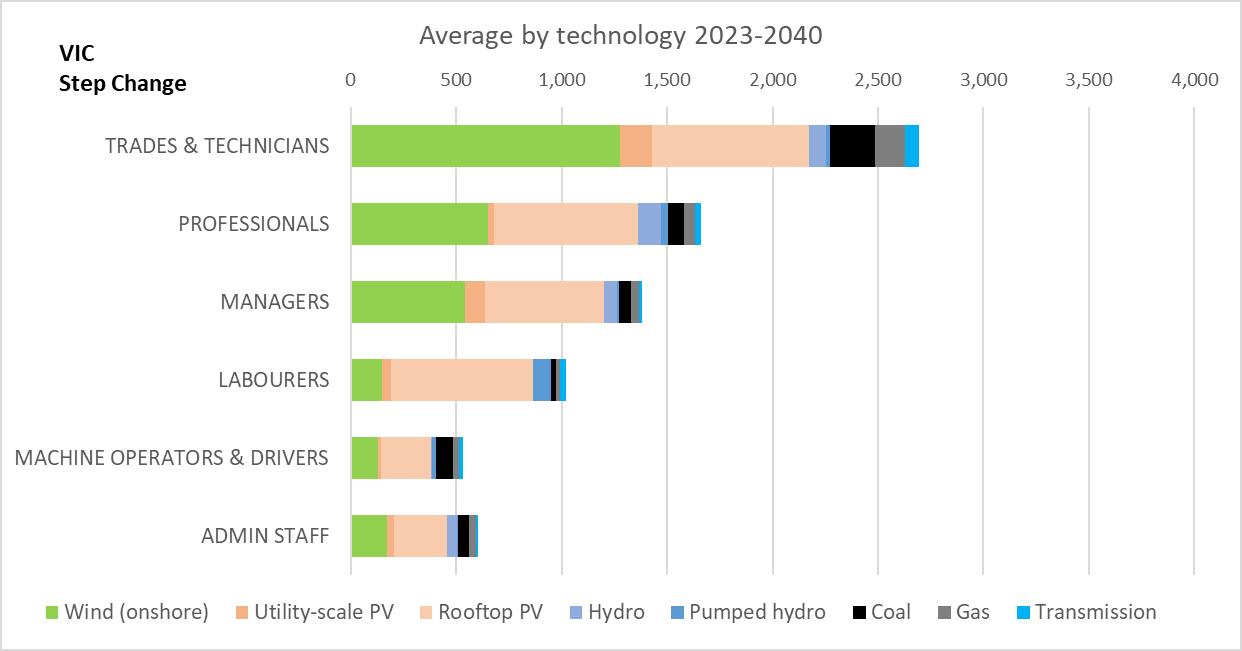

• The next largest groups are professionals (around 1,700 per year across a wide range of occupations including finance, health and safety, engineers – or over 2,200 for Hydrogen Superpower) and managers (over 1,500 per year led by construction managers – or over 1,900 and 800 for the Hydrogen Superpower scenario)
• Over 1,100 labourers are projected per year (especially construction labourers), around 1,500 machine operators and drivers (e.g., truck drivers, crane operators) and around 600 administrative staff. Under the Hydrogen Superpower scenario, there would be demand for around 1,300 labourers and around 1,400 machine operators and drivers and administrative staff combined.
Electricity Sector Workforce Projections for the 2022 ISP: Focus on Victoria 10
Figure 5 Victoria, average occupational structure
From the perspective of skills, training, and labour supply, the peaks in employment are the most important, with training provision in the medium term likely to be designed to cater to the next ten to fifteen years. The peak labour year in this period is chosen to illustrate requirements for the most in-demand occupations.

Labour requirements in 2033 (the peak year before 2035 in the Step Change scenario) are shown in Figure 6. There are nearly 1,800 electricians and 700 mechanical trades and technicians needed in the Step Change scenario. In the Hydrogen Superpower these requirements are much higher, with more than 1,800 electricians and 700 mechanical trades needed. Annual requirements for in-demand occupations in the Hydrogen Superpower scenario are shown in Appendix A.
Annual requirements for the six most in-demand occupations over the entire period are shown in Figure 7. Those occupations needed in large numbers primarily during construction (such as construction labourers and managers, and electrical engineers) are very volatile, while occupations such as electricians and mechanical trades increase steadily over the entire period.
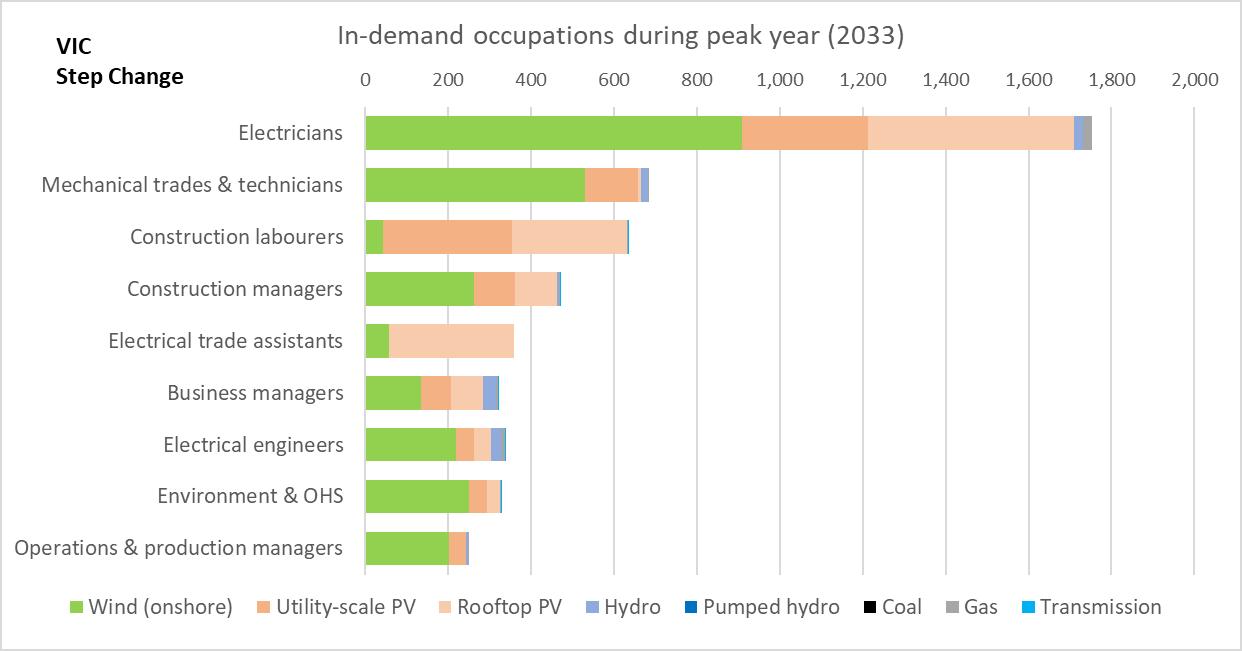
Electricity Sector Workforce Projections for the 2022 ISP: Focus on Victoria 11
Figure 6 Victoria, in-demand occupations during Step Change peak year (2033)


Electricity Sector Workforce Projections for the 2022 ISP: Focus on
12
Victoria
Figure 7 Victoria, in-demand occupations annual requirement by technology, Step Change
Note different scales: electricians 0-2,000; all others 0-800.
4 Workforce projections by technology for Victoria

Under all scenarios, most employment growth occurs in solar and onshore wind farms. Figure 8 shows the average employment by technology over the period, while Figure 9 shows the annual variation.
• The combined workforce for rooftop solar and distributed batteries accounts for more than 45% of electricity sector employment in all scenarios. Rooftop solar is a steady source of employment, with average annual employment between 6,200 and 7,200 in all but the Slow Change scenario; in Slow Change rooftop solar employment averages 3,900. Jobs in distributed batteries generally increase steadily over the period, from 1,000 in 2023 to close to 4,000 in 2050 in the Step Change, Hydrogen Superpower, and Offshore Wind scenarios. In the Slow Change scenario there is much less installation of batteries, and employment is only 700 at the end of the period. Distributed batteries contribute more than 97 % of the battery jobs shown.
• Wind accounts for an average of between 25% in the Slow Change scenario, and up to 36% of all employment in the Hydrogen Superpower scenario. Wind accounts for a lower proportion of the total employment in the Offshore Wind scenario (27% compared to 29% in the Step Change scenario), reflecting the fact that offshore wind is less labour intensive than onshore wind or solar farms. Offshore wind itself accounts for 6% of employment on average in this scenario and reaches a maximum of 13%
• Solar farms account for an average of between 2% of employment in the Slow Change and 10% of employment in the Hydrogen Superpower scenario
Repowering is replacing wind turbines or solar panels, either at the end of their life, or because technology improvements mean that the replacements are sufficiently higher performance to make replacement economic. Repowering is included for wind, utility-scale solar, and rooftop solar, with employment factors and construction times assumed to remain the same. Employment associated with recycling of panels or turbines is not included.
Electricity Sector Workforce Projections for the 2022 ISP: Focus on Victoria 13

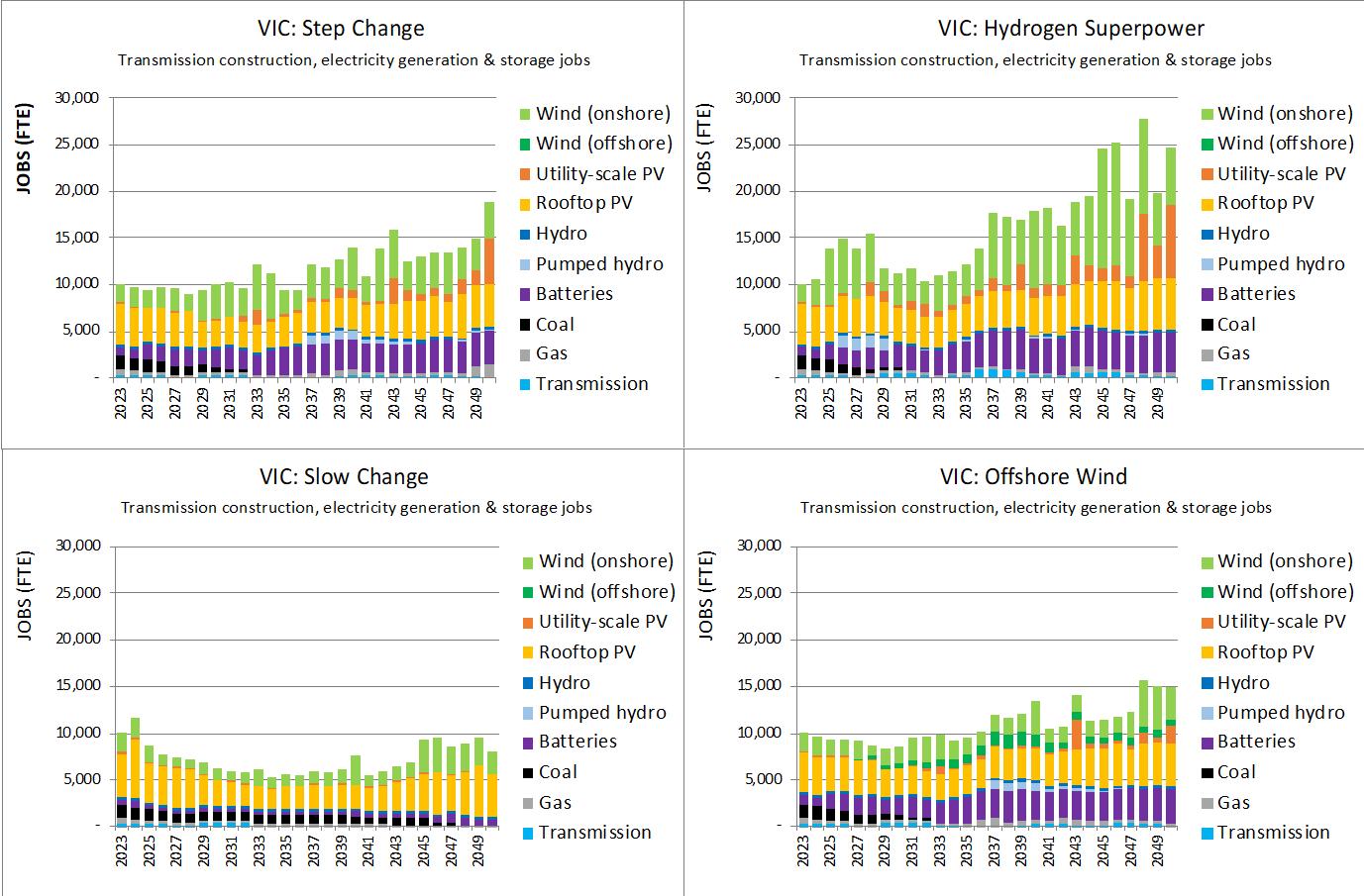
Electricity Sector Workforce Projections for the 2022 ISP: Focus on
14
Victoria
Figure 8 Victoria, average electricity sector jobs by technology and scenario
Figure 9 Victoria, jobs by technology (all scenarios)
4.1 Wind
Total jobs in wind power for all four scenarios are shown in Figure 10 with an average of between 2,000 in the Slow Change and up to 6,000 in the Hydrogen Superpower scenario In the Step Change employment fluctuates after increasing reasonably steadily until the late 2020s Repowering starts playing a noticeable role in all scenarios the late 2030s, reaching a maximum of nearly 2,000 in 2040.
Figure 10 Victoria, jobs in wind (all scenarios)


Note different scale for hydrogen Superpower

Electricity Sector Workforce Projections for the 2022 ISP: Focus on Victoria 15
In the Offshore Wind scenario, the average wind employment is around 500 below the Step Change scenario. This reflects the lower labour intensity of offshore compared to onshore wind and the fact that offshore tends to displace onshore wind capacity. Onshore wind has greater fluctuations in the 2020s and peaks during the 2030s, followed by a slight decline and then remaining steady during the 2040s. Only in the late 2040s, employment in onshore wind grows again significantly to up to 5,000 jobs in 2048 and 2049.
Employment is greatest in the Hydrogen Superpower scenario has with an average of 5,900 jobs. After a dip in the 2030s employment grows steadily until 2039 and starts playing a more important role with a peak in repowering jobs in 2040 and 2046. Average employment in the Slow Change is only 2,000 with marginal growth until 2045.
4.2 Rooftop solar and distributed batteries
Employment in rooftop solar and distributed batteries are shown for the scenarios in Figure 11. Rooftop solar provides steady employment, with most of the growth and variability coming from installation of batteries. The employment profile is very similar between the Step Change and the Hydrogen Superpower average (average of 6,200 to 7,200 per year), with the Slow Change significantly lower at 3,900. Rooftop solar repowering starts playing a noticeable role in the mid-2030s.
4.3 Utility-scale PV
Total jobs in utility-scale PV for all scenarios are shown in Figure 12 with an average of between 100 in the Slow Change and up to 1,600 in the Hydrogen Superpower scenario.
In the Step Change scenario utility-scale PV employment averages nearly 800, and only starts to play a role in the 2030s to reach a maximum of just over 4,000 by the end of the period. Repowering does not play a noticeable role.

Employment in the Offshore Wind scenario is significantly lower, as offshore wind displaces both onshore wind and utility solar.

Electricity Sector Workforce Projections for the 2022 ISP: Focus on Victoria 16
Figure 11 Victoria, jobs in rooftop solar and distributed batteries (all scenarios)
Utility-scale PV only takes off significantly in the Hydrogen Superpower scenario, where it grows steadily from the late-2020s. Employment averages just 1,600 jobs and reaches a maximum approaching 8,000. Average employment in the Slow Change is only 100
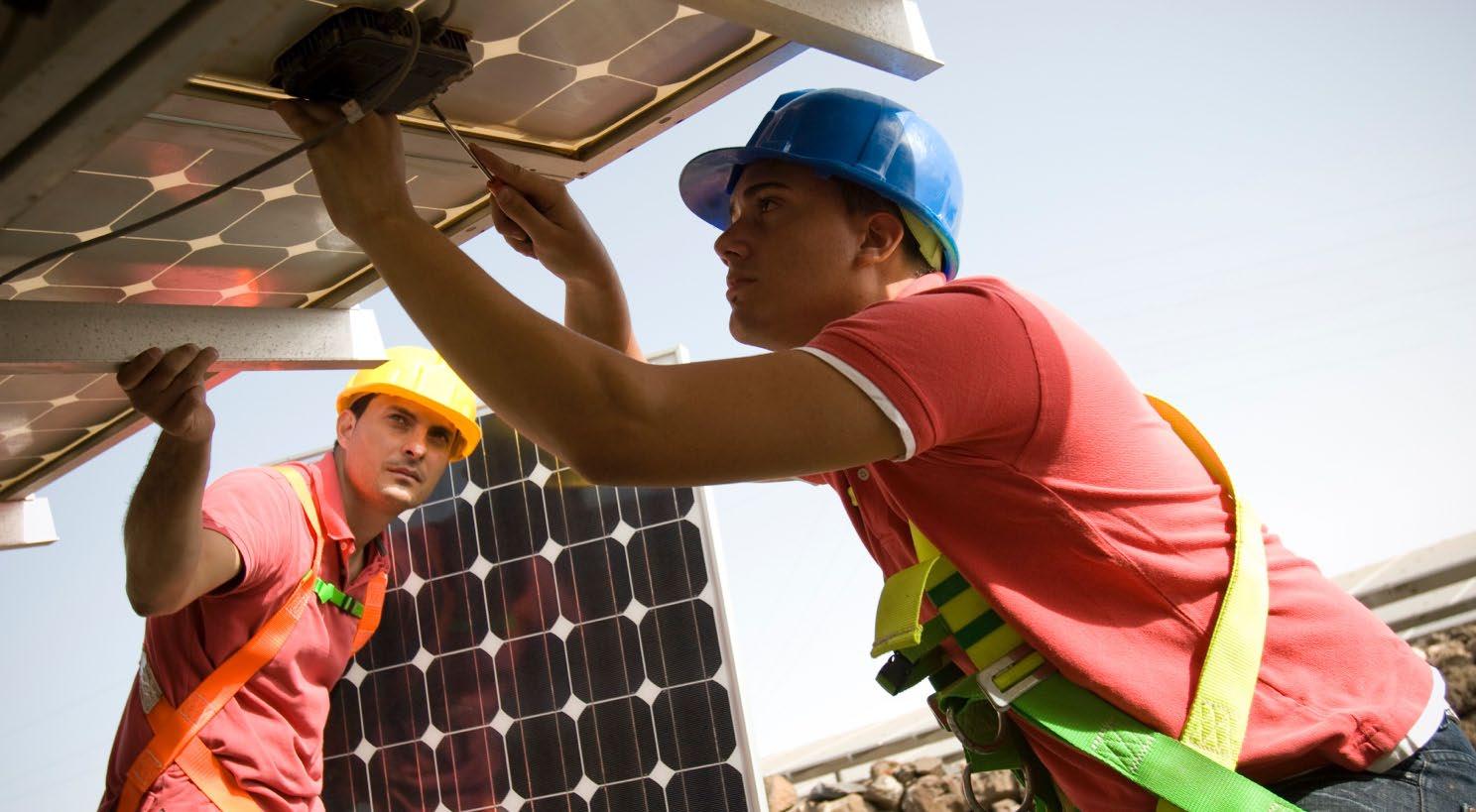

Note

Electricity Sector Workforce Projections for the 2022 ISP: Focus on Victoria 17
Figure 12 Victoria, jobs in utility-scale solar (all scenarios)
different scale for Hydrogen Superpower
4.4 Large scale storage: utility batteries and pumped hydro


The storage jobs are shown in Figure 13 and Figure 14 for the Step Change, Hydrogen Superpower, and Slow Change scenarios, noting that the scale for pumped hydro (Figure 13) goes from 0-1,400 and the scale for batteries employment goes from 0-400. Offshore Wind is not shown as the profile is the same as the Step Change scenario. Jobs in pumped hydro are volatile, reflecting the periods when new facilities are constructed. There are no jobs in the Step Change until the late 2030s with about 1,000 and 400 jobs in the two construction periods, with a period of low employment reflecting the O&M jobs in between the two build periods and subsequently. The Hydrogen Superpower scenario has an even peakier profile, as the two projects are constructed simultaneously between 2027 to 2029, requiring more than 1,500 jobs per year. Utility batteries employment is sporadic in all scenarios, corresponding with periods when installations occur, and never goes above 400 (Figure 14).

Electricity Sector Workforce Projections for the 2022 ISP:
18
Focus on Victoria
Figure 13 Victoria, jobs in pumped hydro (Step Change, Hydrogen Superpower, Slow Change)
Figure 14 Victoria, jobs in utility batteries (Step Change, Hydrogen Superpower, Slow Change)
4.5 Transmission construction
Employment in transmission construction is compared for three scenarios in Figure 15 (Offshore Wind is identical to the Step Change scenario), with the employment peaks representing the periods when lines are under construction.
Transmission employment averages 200 jobs for the Step Change scenario, 400 jobs for the Hydrogen Superpower scenario, and 100 jobs for the Slow Change scenario. The Hydrogen Superpower scenario maintains labour demand throughout the period as the transmission system is expanded to service the growth in wind and solar, with a peak of 900 at the end of the 2020s. Step Change transmission employment is lower, with peaks at just under 400 jobs in 2030 and 2046.

It should be noted that actual employment is likely to be more variable than shown here, as these calculations assume that employment is spread evenly across the construction period for each project.

Electricity Sector Workforce Projections for the 2022 ISP: Focus on Victoria 19
Figure 15 Victoria, jobs in transmission construction (Step Change, Hydrogen Superpower, Slow Change)
5 Electricity sector workforce projections, by REZ
In Victoria, over 22.7 GW of new utility-scale wind and solar renewable generation is projected in the ISP for the candidate REZs by 2050. It is not yet determined which REZs will go ahead, so four were selected based on the most significant renewable capacity shown in the ISP. Figure 16 shows the candidate REZs identified in the ISP, with the four modelled here indicated in red
They are Murray River, Western Victoria, South West Victoria, and Gippsland, noting that the employment associated with any offshore development in Offshore Zone 3 has been allocated to Gippsland. Employment associated with electricity infrastructure in the rest of the Victoria, including the other REZs, has been modelled as ‘Rest of Victoria’.

Electricity Sector Workforce Projections for the 2022 ISP: Focus on Victoria 20
Figure 16 Candidate REZs for Victoria, and the REZs with modelled employment
The distribution of employment growth across the REZs is shown in Figure 17 and varies somewhat by scenario. In the Hydrogen Superpower scenario South West Victoria grows almost triple the amount in the other scenarios, with an average of over 3,000 jobs, while growth in Gippsland more than doubles compared to the Step Change. In contrast, the Offshore Wind scenario shows lower employment in all REZs apart from Gippsland

Figure 18 shows the utility battery employment in the Step Change scenario for the Western Victoria REZ (the only REZ with an identifiable utility battery project) and the rest of Victoria. There is very little employment other than during a couple of construction periods.




Electricity Sector Workforce Projections for the 2022 ISP: Focus on Victoria 21
Figure 17 Employment by Victorian REZ (all scenarios)
Figure 18 Employment in utility batteries by REZ and rest of Victoria, Step Change
Note different scale for Hydrogen Superpower
Utility-scale solar employment in the Murray River, Western Victoria, and the rest of Victoria is compared for the Step Change and Offshore Wind scenarios in Figure 19, noting that these are the ISP projections and actual capacity dispersal between REZs is likely to be impacted by the Victorian REZ development policies

There is a significant difference between the offshore wind, with employment dropping noticeably in the Offshore Wind scenario, reflecting the 50% reduction (5.7 GW) in utility-scale solar capacity in this scenario by 2050
Employment in Murray River drops from an average of 400 jobs to 300, while Western Victoria sees their peak employment drop from nearly 3,000 to only 500. Repowering of utility solar starts to play a role during the 2040s.
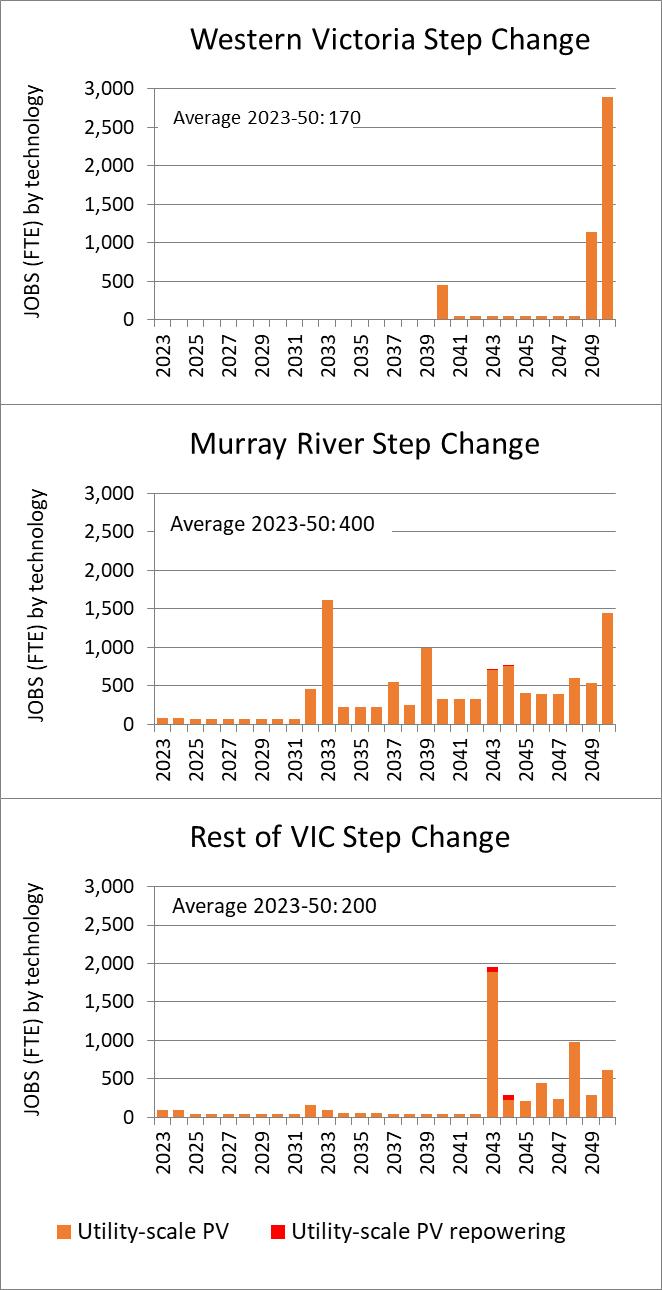
Electricity Sector Workforce Projections for the 2022 ISP: Focus on Victoria 22
Figure 19 Employment in utility-scale PV by Victorian REZ, Step Change and Offshore Wind
with an estimated 1.4 job-years/MW construction employment compared to 2.7 job-years per MW for onshore wind.
The variation is greater for individual REZs The average employment in South West Victoria is not affected greatly, dropping from 1,200 to 1,000 Gippsland sees average employment increase from 600 to 800, with a shift from onshore wind to offshore wind. In Western Victoria the reduction in employment is significant, from 1,100 to 500, as onshore wind is displaced. In the rest of Victoria total wind employment is somewhat lower in the Offshore Wind scenario


Electricity Sector Workforce Projections for the 2022 ISP: Focus on Victoria 23
Figure 20 Employment in wind technology by Victorian REZ, Step Change and Offshore Wind
Figure 20 compares wind employment for three REZs and the rest of Victoria in the Step Change and Offshore Wind scenarios. Overall wind employment drops from an average of 3,400 to 2,900 in the Offshore Wind scenario (Figure 10), The overall reduction is both because offshore technology displaces somewhat more onshore capacity than is installed offshore, with overall wind capacity falling by 0.6 GW by 2050. Onshore wind is also more labour intensive,






















































